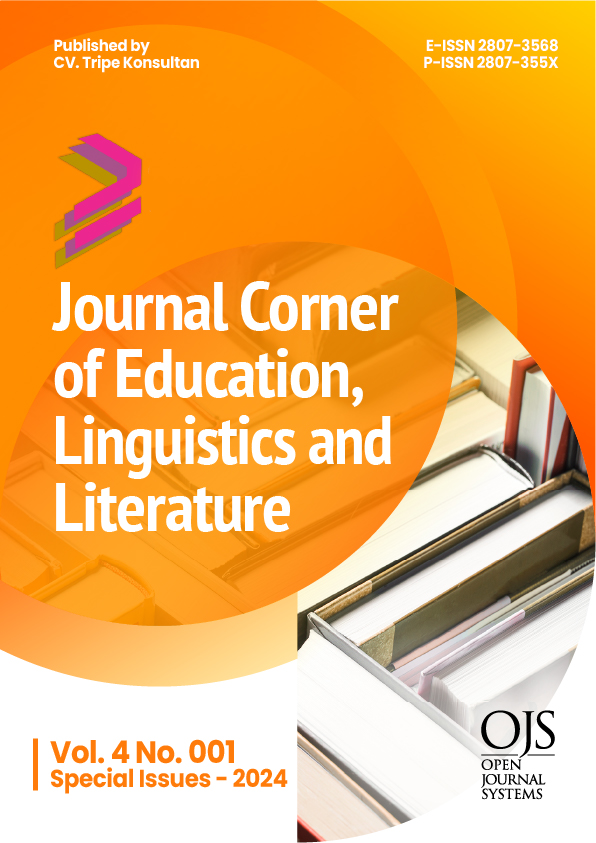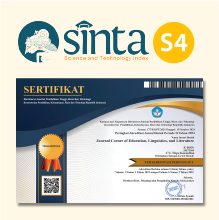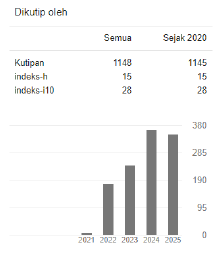Analysis of X-COMP in Periphrastic Causative Constructions: The Case of the Duri Dialect in the Massenrempulu Language
 https://doi.org/10.54012/jcell.v4i001.385
https://doi.org/10.54012/jcell.v4i001.385
 Abstract views: 101
Abstract views: 101
 PDF downloads: 88
PDF downloads: 88
Keywords:
Causative, X-COMP, Language, Massenrempulu, PeriphrasticAbstract
Periphrastic causative constructions elucidate the causal relationship between two actions inside a single event. The periphrastic causative construction includes X-COMP in the subordinate sentence. This research on X-COMP in the Massenrempulu language employs a descriptive methodology. Data sources derive from written and spoken speech, particularly those featuring the X-COMP form. Data gathering was executed using reading, note-taking, and interviewing methodologies. The employed data analysis method is qualitative descriptive analysis. The causal periphrasis structure in the Duri dialect of the Massenrempulu language is constituted by the verbs kuanni and mangkabua. X-COMP in the causal periphrastic construction of the Massenrempulu language has traits similar to X-COMP in other global languages. The attributes of X-COMP in the Massenrempulu language are contingent upon the subject or object of the principal clause and the existence of the verb that constitutes the causal construction within the principal clause.
Downloads
References
Alwi, H. (2019). Tata Bahasa Baku Bahasa Indonesia. Jakarta:Balai Pustaka.
Budiarta, I. W. (2015). Konstruksi Kausatif Analitik Bahasa Kemak. RETORIKA: Jurnal Ilmu Bahasa, 1(1), 35–51.
Creswell, J. W. (2010). Research Design Pendekatan Kualitatif, Kuantitatif, dan Mixed. Yogyakarta: Pustaka Pelajar.
Fathonah, S., & Romadhan, A. D. (2021). Active and Passive Voice In Bulungan Language. Rainbow: Journal of Literature, Linguistics and Culture Studies, 10(2), 96–105.
Hanafie, S. H., Lagousi, K., Junaedie, M., Nur, S. H. J., & Sikki, M. (1983). Morfologi dan Sintaksis bahasa Massenrempulu. Pusat Pembinaan dan Pengembangan Bahasa.
Kaplan, R. M., & Bresnan, J. (1981). Lexical-Functional Grammar: A Formal System For Grammatical Representation. Massachusetts Institute Of Technology, Center For Cognitive Science.
Mahsun, M. (2017). Metode Penelitian Bahasa. Tahapan, Strategi, Metode, dan Tekniknya. Rajawali Press.
Nengsi, U. (2024). Analisis Kontrastif Pada Kausatif Analitik Bahasa Massenrempulu Dialek Duri Dan Bahasa Indonesia (Kajian Sintaksis). Universitas Borneo Tarakan.
Romadhan, A. D. (2019). X-Komp Bahasa Indonesia: Analisis Tata Bahasa Leksikal Fungsional. Edukasia: Jurnal Pendidikan, 6(1), 26–29.
Romadhan, A. D., Hakim, L., Selia, A. K. W., Ekasani, K. A., Wuarlela, M., Hiariej, C., Janggo, W. O., Kami, P., Raja, F. D., & Susanti, R. (2023). Pengantar Linguistik Umum. CV. Intelektual Manifes Media.
Romadhan, A. D., & Sari, R. K. (2021). Subjecthood In Punan Tebunyau Language: Kesubjekan Bahasa Punan Tebunyau. Jurnal Kata: Penelitian Tentang Ilmu Bahasa Dan Sastra, 5(2), 224–234.
Saragih, E. L. L., & Mulyadi, M. (2022). Konstruksi Kausatif Bahasa Batak Toba dan Bahasa Mandailing: Kajian Tipologis Bahasa. Ranah: Jurnal Kajian Bahasa, 11(1), 94–102.
Selia, A. K. W., & Romadhan, A. D. (2023). Subjecthood in Banjarnese. Indonesian Journal of EFL and Linguistics, 8(2), 263–277.
Sikki, M., Hakim, Z., Mulya, A. K., & Rijal, S. (1997). Tata Bahasa Massenrempulu. Pusat Pembinaan Dan Pengembangan Bahasa.
Subiyanto, A., & Suryadi, M. (2023). Kausatif Morfologi Dalam Bahasa Gorontalo. Literasi: Jurnal Ilmiah Pendidikan Bahasa, Sastra Indonesia Dan Daerah, 13(1), 101–111.
Sudaryanto. (2018). Metode dan Aneka Teknik Analisis Bahasa: Pengantar penelitian Wahana Kebudayaan Secara Linguistis. Duta Wacana University Press.
Downloads
Published
How to Cite
Issue
Section
License
Copyright (c) 2024 Siti Fathonah, Rita Kumalasari

This work is licensed under a Creative Commons Attribution-ShareAlike 4.0 International License.
All articles published in the Journal Corner of Education, Linguistics, and Literature are licensed under the Creative Commons Attribution-ShareAlike License (CC BY-SA).

















